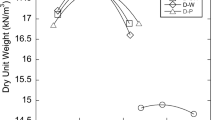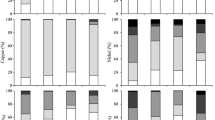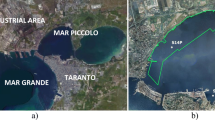Abstract
The environmental assessment of potential effects of contaminated harbor sediments stabilized with hydraulic binders and the determination of remediation endpoints require the determination of pollutants leaching potentials. Moreover, little information about the speciation and mobility of inorganic contaminants in these specific solid matrices is available in the literature. The objective of this paper is to investigate the relationship between mineralogy and leachability of contaminants (copper, lead, and zinc) present in a French harbor sediment stabilized with quicklime and Portland cement. Batch equilibrium leaching tests at various pH, chemical analysis of leachates, and mineralogical studies (X-ray diffraction, scanning electron microscopy–energy dispersive spectroscopy, and diffuse reflectance infrared Fourier transform) have been combined in the present investigation. The acid neutralization capacity of the stabilized matrix studied is first controlled by the dissolution of portlandite (pH ~12), followed by the dissolution of C–S–H (pH ~11) and the dissolution of ettringite (pH ~10). Finally, a very high buffering capacity of this stabilized sediment is observed for pH values around 6. This equilibrium is mainly controlled by the dissolution of iron sulfides and carbonate minerals. Consequently, the mobilization of inorganic contaminants as a function of pH remains very low (<0.1 wt%) for pH values above 6 and significantly increases for pH below these values. This research confirms the importance of a combined methodology for the intrinsic characterization of potential mobilization of contaminants in a stabilized sediment and for a better understanding of geochemical processes that affect contaminant fate, transformation, and transport in the subsurface environment.







Similar content being viewed by others
References
AFNOR (Association Française de NORmalisation) (1996) Qualité des sols—Sols, sédiments—Mise en solution totale par attaque acide, NF X31-147. AFNOR Editions, Paris
Alzieu C (1999) Dragages et Environnement Marin: Etat des Connaissances. IFREMER, Nantes
Aouad G, Laboudigue A, Gineys N, Abriak NE (2012) Dredged sediments used as novel supply of raw material to produce Portland cement clinker. Cement Concr Compos 34:788–793. doi:10.1016/j.cemconcomp.2012.02.008
Barakat AO, Mostafa A, Wade TL, Sweet ST, El Sayed NB (2011) Distribution and characteristics of PAHs in sediments from the Mediterranean coastal environment of Egypt. Mar Pollut Bull 62:1969–1978
Barna R, Sanchez F, Moszkowicz P, Méhu J (1997) Leaching behavior of pollutants in stabilized/solidified wastes. J Hazard Mater 52:287–310
Benzaazoua M, Belem T, Bussière B (2002) Chemical factors that influence on the performance of mine sulphidic paste backfill. Cem Concr Res 32:1133–1144
Benzaazoua M, Fall M, Belem T (2004) A contribution to understanding the hardening process of cemented pastefill. Miner Eng 17:141–152
Brennan EW, Lindsay WL (1996) The role of pyrite in controlling metal ion activities in highly reduced soils. Geochim Cosmochim Acta 60:3609–3618
Caille N, Tiffreau C, Leyval C, Morel JL (2003) Solubility of metals in an anoxic sediment during prolonged aeration. Sci Total Environ 301:239–250
Caplat C, Texier H, Barillier D, Lelievre C (2005) Heavy metals mobility in harbour contaminated sediments: the case of Port-en-Bessin. Mar Pollut Bull 50:504–511
Cartledge FK, Butler LG, Chalasini D, Eaton HC, Frey FP, Herrera E, Tittlebaum ME, Yang SL (1990) Immobilization mechanisms in solidification/stabilization of cadmium and lead salts using Portland cement fixing agents. Environ Sci Technol 24:867–873
Casado-Martínez MC, Buceta JL, Belzunce MJ, DelValls TA (2006) Using sediment quality guidelines for dredged material management in commercial ports from Spain. Environ Int 32:388–396
Casado-Martínez MC, Forja JM, DelValls TA (2009) A multivariate assessment of sediment contamination in dredged materials from Spanish ports. J Hazard Mater 163:1353–1359
Cassi R, Tolosa I, Mora SD (2008) A survey of antifoulants in sediments from Ports and Marinas along the French Mediterranean coast. Mar Pollut Bull 56:1943–1948
Chatain V, Sanchez F, Bayard R, Moszkowicz P, Gourdon R (2005) Effect of experimentally induced reducing conditions on the mobility of arsenic from a mining soil. J Hazard Mater 122:119–128
Coussy S, Benzaazoua M, Blanc D, Moszkowicz P, Bussière B (2012) Assessment of arsenic immobilization in synthetically prepared cemented paste backfill specimens. J Environ Manage 93:10–21
Dalton JL, GardnerKH STP, Weimer ML, Spear JCM, Magee BJ (2004) Properties of Portland cement made from contaminated sediments. Resour Conserv Recycl 41:227–241
Dutré V, Kestens C, Schaep J, Vandecasteele C (1998) Study of the remediation of a site contaminated with arsenic. Sci Total Environ 220:185–194
European Council (2002) Council decision of 19 December 2002 establishing criteria and procedures for the acceptance of waste at landfills pursuant to Article 16 of Annex II to directive 1999/31/EC(2003/33/EC). Off J Eur Communities L11/27 (16.01.03)
French Official Journal (2000) J.O. no. 184 (10 August 2000), 12415 (NOR: ATEE0090254A)
Giampaolo C, Lo Mastron S, Polettini A, Pomi R, Sirini P (2002) Acid neutralisation capacity and hydration behaviour of incineration bottom ash-Portland cement mixtures. Cem Concr Res 32:769–775
Grosdemange D, Lévêque F, Drousie D, Aqua JL, Méhu J, Bazin C (2008) The SEDIMARD project: presentation and results. In: International Symposium on Sediment Management (I2SM), Lille, France
Guevara-Riba A, Sahuquillo A, Rubio R, Rauret G (2004) Assessment of metal mobility in dredged harbour sediments from Barcelona, Spain. Sci Total Environ 321:241–255. doi:10.1016/j.scitotenv.2003.08.021
Huerta-Diaz MA, Tessier A, Carignan R (1998) Geochemistry of trace metals associated with reduced sulfur in freshwater sediments. Appl Geochem 13:213–233
Isaure MP, Laboudigue A, Manceau A, Sarret G, Tiffreau C, Trocellier P, Lamble G, Hazemann JL, Chateigner D (2002) Quantitative Zn speciation in a contaminated dredged sediment by μ-PIXE, μ-SXRF, EXAFS spectroscopy and principal component analysis. Geochim Cosmochim Acta 66:1549–1567
Kosson DS, van der Sloot HA, Sanchez F, Garrabrants AC (2002) An integrated framework for evaluating leaching in waste management and utilization of secondary materials. Environ Eng Sci 19:159–204
Kundu S, Gupta AK (2008) Immobilization and leaching characteristics of arsenic from cement and/or lime solidified/stabilized spent adsorbent containing arsenic. J Hazard Mater 153:434–443
Lions J, Guérin V, Bataillard P, van der Lee J, Laboudigue A (2010) Metal availability in a highly contaminated, dredged-sediment disposal site: field measurements and geochemical modeling. Environ Pollut 158:2857–2864
Loustau Cazalet M, Chatain V, de Brauer C, Blanc D, Delolme C, Borschneck D (2010) Comportement et mobilisation potentielle de polluants inorganiques présents dans un sédiment marin traité à la chaux vive et aux liants hydrauliques. In: International conference on “Water, Waste and Sustainable Development” (E3D), Alexandria, Egypt, 257–263
Lowson RT (1982) Aqueous oxidation of pyrite by molecular oxygen. Chem Rev 82:461–497. doi:10.1021/cr00051a001
Mamindy-Pajany Y, Géret F, Roméo M, Hurel C, Marmier N (2012) Ex situ remediation of contaminated sediments using mineral additives: assessment of pollutant bioavailability with the Microtox solid phase test. Chemosphere 86:1112–1116
Martínez-Lladó X, Gibert O, Martí V, Díez S, Romo J, Bayona JM, de Pablo J (2007) Distribution of polycyclic aromatic hydrocarbons (PAHs) and tributyltin (TBT) in Barcelona harbour sediments and their impact on benthic communities. Environ Pollut 149:104–113
Morillo J, Usero J, Gracia I (2004) Heavy metal distribution in marine sediments from the southwest coast of Spain. Chemosphere 55:431–442
Morse JW, Luther GM (1999) Chemical influences on trace metal-sulfide interactions in anoxic sediments. Geochim Cosmochim Acta 63:3373–3378
Mulligan CN, Yong RN, Gibbs BF (2001) An evaluation of technologies for the heavy metal remediation of dredged sediments. J Hazard Mater 85:145–163
Ouellet S, Bussière B, Mbonimpa M, Benzaazoua M, Aubertin M (2006) Reactivity and mineralogical evolution of an underground mine sulphidic cemented paste backfill. Miner Eng 19:407–419. doi:10.1016/j.mineng.2005.10.006
Peyronnard O, Blanc D, Benzaazoua M, Moskowicz P (2009) Study of mineralogy and leaching behavior of stabilized/solidified sludge using differential acid neutralization analysis. Part II: use of numerical simulation as an aid tool for cementitious hydrates identification. Cem Concr Res 39:501–509
Quevauviller P, Rauret G, López-Sánchez JF, Rubio R, Ure A, Muntau H (1997) Certification of trace metal extractable contents in a sediment reference material (CRM 601) following a three-step sequential extraction procedure. Sci Total Environ 205:223–234
Rietveld HM (1993) In: Young RA (ed) The Rietveld method. Oxford University Press, Oxford
Roberts DA (2012) Causes and ecological effects of resuspended contaminated sediments (RCS) in marine environments. Environ Int 40:230–243
Sakellari A, Plavšić M, Karavoltos S, Dassenakis M, Scoullos M (2011) Assessment of copper, cadmium and zinc remobilization in Mediterranean marine coastal sediments. Estuar Coast Shelf Sci 91:1–12
Schippers A, Jørgensen BB (2002) Biogeochemistry of pyrite and iron sulfide oxidation in marine sediments. Geochim Cosmochim Acta 66:85–92
Stegemann AJ, Buenfeld RN (2002) Prediction of leachate pH for cement paste containing pure metal compounds. J Hazard Mater B90:169–188
Sundaray SK, Nayak BB, Lin S, Bhatta D (2011) Geochemical speciation and risk assessment of heavymetals in the river estuarine sediments—a case study: Mahanadi basin, India. J Hazard Mater 186:1837–1846
Tessier A, Campbell PGC, Bisson M (1979) Sequential extraction procedure for the speciation of particulated metals. Anal Chem 51:844–851
Usero J, Gamero M, Morillo J, Gracia I (1998) Comparative study of three sequential extraction procedures for metals in marine sediments. Environ Int 24:487–496
Van der Sloot HA, Heasman L, Quevauviller P (1997) Harmonization of leaching/extraction tests. Studies in environmental science 70. Elsevier, Amsterdam
Vandecasteele C, Dutré V, Geysen D, Wauters G (2002) Solidification/stabilization of arsenic bearing fly ash from the metallurgical industry: immobilization mechanism of arsenic. Waste Manage 22:143–146
Yap CK, Ismail A, Tan SG, Omar H (2002) Concentrations of Cu and Pb in the offshore and intertidal sediments of the west coast of Peninsular Malaysia. Environ Int 28:467–479
Ye S, Laws EA, Zhong S, Ding X, Pang S (2011) Sequestration of metals through association with pyrite in subtidal sediments of the Nanpaishui Estuary on the Western Bank of the Bohai Sea, China. Mar Pollut Bull 62:934–941
Yousuf M, Mollah A, Rajan K, Vempati T, Lin C, Cocke DL (1995) The interfacial chemistry of solidification/stabilization of metals in cement and pozzolanic material systems. Waste Manage 15:137–148
Acknowledgments
The research presented in this paper was supported by the French national research agency (ANR, France). The authors are grateful to EEDEMS (French research network on waste and polluted materials management) and POLDEN (French applied research and consultancy team on environment, waste, and polluted materials management) for experimental support. Author’s acknowledgements also go to University of Quebec (UQAT) for their support in the mineralogical analyses.
Author information
Authors and Affiliations
Corresponding author
Additional information
Responsible editor: Philippe Garrigues
Rights and permissions
About this article
Cite this article
Chatain, V., Benzaazoua, M., Loustau Cazalet, M. et al. Mineralogical study and leaching behavior of a stabilized harbor sediment with hydraulic binder. Environ Sci Pollut Res 20, 51–59 (2013). https://doi.org/10.1007/s11356-012-1141-4
Received:
Accepted:
Published:
Issue Date:
DOI: https://doi.org/10.1007/s11356-012-1141-4




